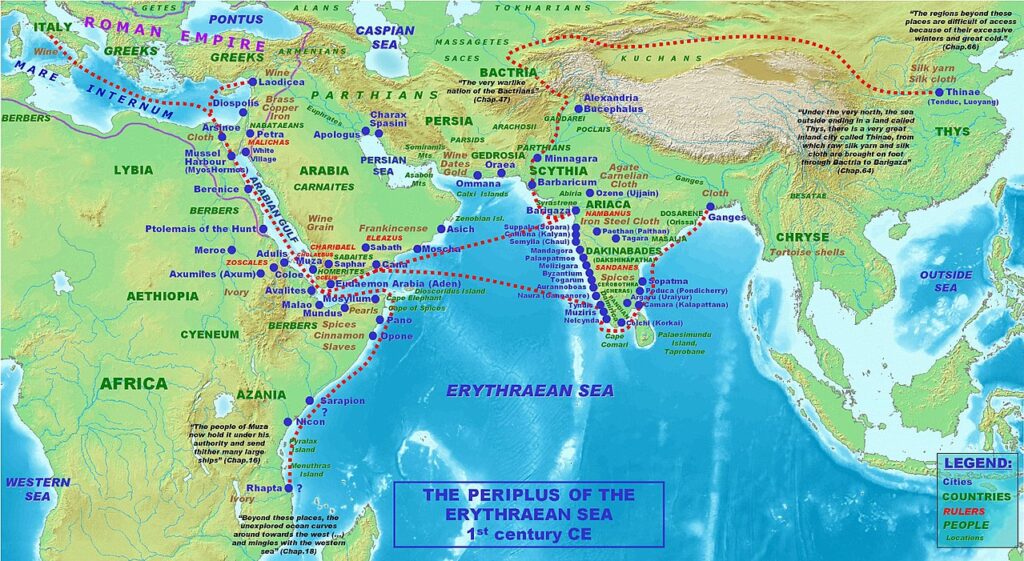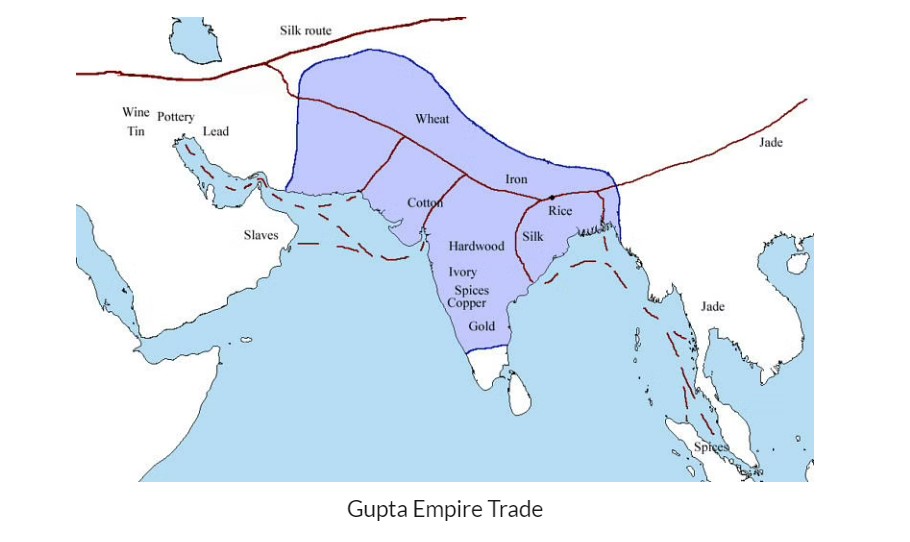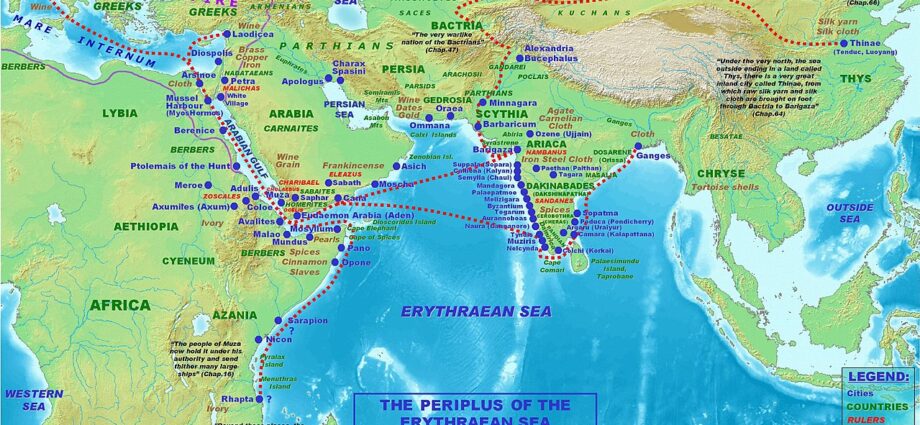During the golden period – from the 1st century to the 6th century – Hindu religion, culture and traditions were diffusing deep into Southeast Asia, powered by the economic might of the Gupta dynasty. But it was the trade with distant Rome that brought India untold riches. India’s GDP was the highest and massive 25% of the world, and its status in the world was like that of today’s USA. People in Southeast India loved to adopt the Hindu names just like today’s Indian youths like to call themselves Jimmy and Harry.
Rome used to import spices for food, perfume, textiles, ivory, precious stones, medicinal and magic potions and exotic animals to be used in circuses from India while selling clothes, linens, topaz, coral, cups of glass, silver and gold plates and wine. Such was the deficit on the Roman side that its trade with India drained away large amounts of gold from the Roman economy. In one count, 100 million sesterces (Roman coins) were being sent annually to India and China during the 1st century. Pliny, A Roman army commander, laments the economic drain of Rome:
India, China and the Arabian peninsula take one hundred million sesterces from our empire per annum at a conservative estimate: that is what our luxuries and women cost us. For what fraction of these imports is intended for sacrifices to the gods or the spirits of the dead?
— Pliny, Historia Naturae 12.41.84
According to Greek geographer Strabo, at the turn of the first millennium, approximately 120 ships were sailing every year from its Egyptian port of Myos Hormos to India to bring luxury goods. Along with Myos, two other major ports for Indian trade were Arsinoe and Berenice on the Red Sea. In contrast, the western Indian coast had ports every few hundred miles, from Karachi to Mumbai to Muziris in Kerala. Most of the Indian traders were from Magadh, present Bihar and eastern Uttar Pradesh, and frequently used the port of Sopara (Mumbai). The trade path from Mumbai to Bihar needed resthouses and for this purpose, numerous Buddhist and Hindu monasteries were constructed along the way. Ajanta and Ellora are one of them.
Propelling the ships were the southwest monsoon winds, the discovery of which is credited to a Greek navigator named Hippalus. The trade remained all along in the hands of Indian merchants. So much gold was incoming that the Kushans and Guptas had to recycle it for their own coinage. However, despite the extensive trade network, both Hinduism and Buddhism failed to leave any substantial mark on Roman society.
The first three centuries of the first millennium saw stable governments in both India and Rome. However, the continued monetary drain constituted not only an economic crisis but also perpetrated an ideological crisis in Rome. During the 3rd century, there was a calamity – a period of invasions, civil unrest, plague, and economic chaos – in the Roman Empire, leading to a significant decline in trade with India. Due to this trade deterioration, India’s GDP growth also suffered, leading to the decay of the Gupta dynasty. In the early 6th century, when the Huns invaded India, it was all over. They hugely disrupted the trade relations between India and Rome and Central Asia. However, the Arabs and Turks rang the final death knell. In the mid-7th century, Arabs captured Egypt, ejecting Roman Christians and Islamising the country. Egyptian ports then fell in disuse, bringing an end to 670 years of Roman trade with India. Indians, especially Tamils, turned their full attention toward Southeast Asia and established cultural colonies without shedding any blood. Southeast Asians came to be deeply influenced by the peaceful Indic religions. Beginning in the 13th century, Arabs started soft invasions in the form of traders to these countries, replacing Hinduism and Buddhism. Consequently, barring a few pockets of Thailand and Cambodia, the rest of Southeast Asia became either Muslim or Christian. India itself was enslaved by the Turks, hurting its prestige on the world stage. However, India, even then, remained economically powerful till the 18th century. In the 15th century, Ottomans disrupted the Silk route trade, which made European naval powers search for an alternate sea route to India. In 1498, Vasco de Gama made a successful attempt to India through Cape of Good Hope in South Africa, spearheading the European Age of Discovery.


The Pompeii Lakshmi, an ivory figurine, only 25 cm in height, discovered in the ruins of Pompeii, Italy, in 1938, is the perfect example of an exchange of ideas, trade and culture between the two most powerful countries of the world: Rome and India. Pompeii is famous for its ancient majestic frescoes but was destroyed in the eruption of Mount Vesuvius in 79 CE. The figurine was produced in the first century CE in the Gandhara region (now in Afghanistan) of India, as the inscription found at the base is in the Kharosthi script of Gandhara. It was initially thought of as the Hindu goddess Lakshmi. However, later scholars termed it a yakshi – a female spirit of fertility – due to her exposed vulva. It is quite similar to yakshi of Sanchi Stupa of the 3rd century BCE. It is now stored in a museum in Naples.

On the Indian side, however, a plethora of evidence has surfaced lately, corroborating the relations between the two giants. Explorations near Bet Dwarka in Gujarat show several Roman shipwrecks, lead and stone objects. Thousands of Roman gold coins were also found all over the western coast of India. Many Christian and Jewish traders from Rome settled in India even after the decline in the trade. Tamil Sangam literature mentions Yavanas – the Roman traders – in the following verse:
The beautifully built ships of the Yavanas came with gold and returned with pepper, and Muziris resounded with the noise.
Poem no. 149 of ‘Akananuru’ of Sangam Literature
A remnant of a 2000 years old Roman settlement in Arikamedu, near Pondicherry, has been found. India is the only country outside Italy, where Roman ruins have been found. There are multiple representations of such settlers in Indian sculptures. Karle caves in Pune show Roman people in their traditional dresses.
In the end, the Indo-Roman trade remains a golden chapter in the history of India, though Romans may have slightly different notions.
The article is an excerpt from the author’s book titled, “Swift horses Sharp Swords” with some additions.
References:
Warwick Ball, Rome in the East: Transformation of an Empire
Philip DeArmond Curtin, Cross-Cultural Trade in World History.
Moti Chandra, Trade and Trade Routes in Ancient India.
Written by Amit Agarwal, author of the bestsellers on Indian history titled “Swift horses Sharp Swords” and a “Never Ending Conflict”.
Follow him on Twitter @amit1119 and Instagram/ Facebook at amitagarwalauthor.
You may buy his books at the following links:
https://garudabooks.com/a-never-ending-conflict-episodes-from-indic-resistance
https://www.amazon.in/dp/B0B6J5PKPR
https://www.flipkart.com/swift-horses-sharp-swords hindi/p/itma73556f905812?pid=9789355788269 (Hindi)
![]()
- How Hindu rituals spawned numerous advancements in science, maths and other arts - March 13, 2024
- Naga Sadhus and their fighting skills - February 20, 2024
- Lessons for India from the Israel-Palestine conflict - October 12, 2023

